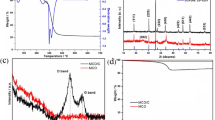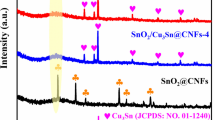Abstract
WS2/carbon nanofibers (WS2/CNFs) are obtained by a simple electrospinning method in which few-/single-layer WS2 is uniformly embedded in carbon fibers. When used as the active anode material for Li-ion cells, these nanofibers exhibit a first-cycle discharge/charge capacity of 941/756 mAh/g at 100 mA/g and maintain a capacity of 458 mAh/g after 100 cycles at 1 A/g. The evolution of size and crystallinity of WS2 with heating treatment are systematically studied, which are found to strongly influence the final electrochemical performance. Interestingly, the WS2 samples of lowest crystallinity show the highest performance among all studied samples, which could result from the large interfacial capacity for Li ions due to their large specific surface area. More interestingly, the inherent flexible attribute of electrospun nanofibers renders them a great potential in the utilization of binder-free anodes. Similar high discharge/charge capacity of 761/604 mAh/g with a first coulombic efficiency of 79.4 % has been achieved in these binder-free anodes. Considering the universal of such simple and scalable preparation strategy, it is very likely to extend this method to other similar two-dimensional layered materials besides WS2 and provides a promising candidate electrode for develo** flexible battery devices.
概要
利用静电纺丝技术制备出少层或单层的WS2纳米片与碳纤维均匀混合的复合材料。该材料表现出优异的锂电性能,在100 mA/g的电流密度下,首次充放电比容量高达941/756 mAh/g。系统地研究了WS2的结晶程度对其电化学性能的影响,发现结晶度越低,材料的锂电性能越好,这可能是由于低结晶性的WS2拥有更大的比表面积,可为锂离子提供了更多的界面储存位点。这种静电纺丝制备的WS2/碳纤维薄膜具有良好的柔韧性,可以直接作为自支撑的负极电极膜使用,并表现出良好的电化学性能。








Similar content being viewed by others
References
Scrosati B, Hassoun J, Sun YK (2011) Lithium-ion batteries. A look into the future. Energy Environ Sci 4:3287–3295
Chen RJ, Zhao T, Wu WP et al (2014) Free-standing hierarchically sandwich-type tungsten disulfide nanotubes/graphene anode for lithium-ion batteries. Nano Lett 14:5899–5904
Duan ZQ, Sun YC, Liu YT et al (2014) Scalable production of transition metal disulphide/graphite nanoflake composites for high performance lithium storage. RSC Adv 4:41543–41550
Chang K, Chen WX (2011) Single-layer MoS2/graphene dispersed in amorphous carbon: towards high electrochemical performances in rechargeable lithium ion batteries. J Mater Chem 21:17175–17184
Li HL, Yu K, Fu H et al (2015) MoS2/graphene hybrid nanoflowers with enhanced electrochemical performances as anode for lithium-ion batteries. J Phys Chem C 119:7959–7968
Zhang JJ, Yu A (2015) Nanostructured transition metal oxides as advanced anodes for lithium-ion batteries. Sci Bull 60:823–838
Song LX, Yang SJ, Wei W et al (2015) Hierarchical SnO2 nanoflowers assembled by atomic thickness nanosheets as anode material for lithium ion battery. Sci Bull 60:892–895
Liu Y, Wang W, Huang HB et al (2014) The highly enhanced performance of lamellar WS2 nanosheet electrodes upon intercalation of single-walled carbon nanotubes for supercapacitors and lithium ions batteries. Chem Commun 50:4485–4488
Chen DY, Ji G, Ding B et al (2013) In situ nitrogenated graphene-few-layer WS2 composites for fast and reversible Li+ storage. Nanoscale 5:7890–7896
Chhowalla M, Shin HS, Eda G et al (2013) The chemistry of two-dimensional layered transition metal dichalcogenide nanosheets. Nat Chem 5:263–275
Rao CNR, Gopalakrishnan K, Maitra U (2015) Comparative study of potential applications of graphene, MoS2, and other two-dimensional materials in energy devices, sensors, and related areas. ACS Appl Mater Interfaces 7:7809–7832
Wang H, Feng HB, Li JH (2014) Graphene and graphene-like layered transition metal dichalcogenides in energy conversion and storage. Small 10:2165–2181
Fang WY, Zhao HB, **e YP (2015) Facile hydrothermal synthesis of VS2/graphene nanocomposites with superior high-rate capability as lithium-ion battery cathodes. ACS Appl Mater Interfaces 7:13044–13052
Zhu CB, Mu XK, van Aken PA et al (2014) Single-layered ultrasmall nanoplates of MoS2 embedded in carbon nanofibers with excellent electrochemical performance for lithium and sodium storage. Angew Chem Int Ed 53:2152–2156
Yu S, Jung JW, Kim ID (2015) Single layers of WS2 nanoplates embedded in nitrogen-doped carbon nanofibers as anode materials for lithium-ion batteries. Nanoscale 7:11945–11950
Liu YC, Zhang N, Kang HY (2015) WS2 nanowires as a high-performance anode for sodium-ion batteries. Chem Eur J 21:11878–11884
Zhang CF, Wang ZY, Guo ZP et al (2012) Synthesis of MoS2-C one-dimensional nanostructures with improved lithium storage properties. ACS Appl Mater Interfaces 4:3765–3768
Hwang H, Kim H, Cho J (2011) MoS2 nanoplates consisting of disordered graphene-like layers for high rate lithium battery anode materials. Nano Lett 11:4826–4830
**ong XQ, Luo W, Hu XL et al (2015) Flexible membranes of MoS2/C nanofibers by electrospinning as binder-free anodes for high-performance sodium-ion batteries. Sci Rep 5:9254
**e XQ, Ao ZM, Su DW et al (2015) MoS2/graphene composite anodes with enhanced performance for sodium-ion batteries: the role of the two-dimensional heterointerface. Adv Funct Mater 25:1393–1403
Feng J, Sun X, Wu CZ et al (2011) Metallic few-layered VS2 ultrathin nanosheets: high two-dimensional conductivity for in-plane supercapacitors. J Am Chem Soc 133:17832–17838
Su DW, Dou SX, Wang GX (2014) WS2@graphene nanocomposites as anode materials for Na-ion batteries with enhanced electrochemical performances. Chem Commum 50:4192–4195
Du YC, Zhu XS, Si L et al (2015) Improving the anode performance of WS2 through a self-assembled double carbon coating. J Phy Chem C 119:15874–15881
Shiva K, Matte H, Rajendra HB et al (2013) Employing synergistic interactions between few-layer WS2 and reduced graphene oxide to improve lithium storage, cyclability and rate capability of Li-ion batteries. Nano Energy 2:787–793
Bhandavat R, David L, Singh G (2012) Synthesis of surface-functionalized WS2 nanosheets and performance as li-ion battery anodes. J Phys Chem Lett 3:1523–1530
Yang GR, Wei Yan, Zhang Q et al (2013) One-dimensional CdS/ZnO core/shell nanofibers via single-spinneret electrospinning: tunable morphology and efficient photocatalytic hydrogen production. Nanoscale 5:12432–12439
Zheng Z, Lin G, Li HQ et al (2015) A fully transparent and flexible ultraviolet–visible photodetector based on controlled electrospun ZnO–CdO heterojunction nanofiber arrays. Adv Funct Mater 25:5885–5894
Zhu LL, Hong MH, Ho GW (2015) Hierarchical assembly of SnO2/ZnO nanostructures for enhanced photocatalytic performance. Sci Rep 5:11609
Zhang HD, Yu M, Zhang JC et al (2015) Fabrication and photoelectric properties of La-doped p-type ZnO nanofibers and crossed p–n homojunctions by electrospinning. Nanoscale 7:10513–10518
Lnagaki M, Yang Y, Kang FY (2012) Carbon nanofibers prepared via electrospinning. Adv Mater 24:2547–2566
Tian W, Zhai TY, Zhang C et al (2013) Low-cost fully transparent ultraviolet photodetectors based on electrospun ZnO–SnO2 heterojunction nanofibers. Adv Mater 25:4625–4630
Ryu WH, Jung JW, Park K et al (2014) Vine-like MoS2 anode materials self-assembled from 1D nanofibers for high capacity sodium rechargeable batteries. Nanoscale 6:10975–10981
Cong X, Cheng C, Liao YM et al (2015) Intrinsic charge storage capability of transition metal dichalcogenides as pseudocapacitor electrodes. J Phys Chem C 119:20864–20870
Liu KK, Zhang WJ, Lee YH et al (2012) Growth of large-area and highly crystalline MoS2 thin layers on insulating substrates. Nano Lett 12:1538–1544
Thripuranthaka M, Late DJ (2014) Temperature dependent phonon shifts in single-layer WS2. ACS Appl Mater Interfaces 6:1158–1163
Choi SH, Boo SJ, Lee JH et al (2014) Electrochemical properties of tungsten sulfide-carbon composite microspheres prepared by spray pyrolysis. Sci Rep 4:5755
Liu H, Su D, Wang GX et al (2012) An ordered mesoporous WS2 anode material with superior electrochemical performance for lithium ion batteries. J Mater Chem 22:17437–17440
Liu Y, Wang W, Wang YW et al (2014) Homogeneously assembling like-charged WS2 and GO nanosheets lamellar composite films by filtration for highly efficient lithium ion batteries. Nano Energy 7:25–32
Acknowledgments
This work was supported by the National Basic Research Program of China (2015CB932600), the National Nature Science Foundation of China (21571073 and 51302099), the Program for HUST Interdisciplinary Innovation Team, the Fundamental Research Funds for the Central University, and Program for New Century Excellent Talents in University (NCET-13-0227). We thank the Analytical and Testing Center of Huazhong University of Science and Technology.
Conflict of interest
The authors declare that they have no conflict of interest.
Author information
Authors and Affiliations
Corresponding authors
Additional information
Shasha Zhou and Junnian Chen contributed equally to this work.
About this article
Cite this article
Zhou, S., Chen, J., Gan, L. et al. Scalable production of self-supported WS2/CNFs by electrospinning as the anode for high-performance lithium-ion batteries. Sci. Bull. 61, 227–235 (2016). https://doi.org/10.1007/s11434-015-0992-8
Received:
Revised:
Accepted:
Published:
Issue Date:
DOI: https://doi.org/10.1007/s11434-015-0992-8




